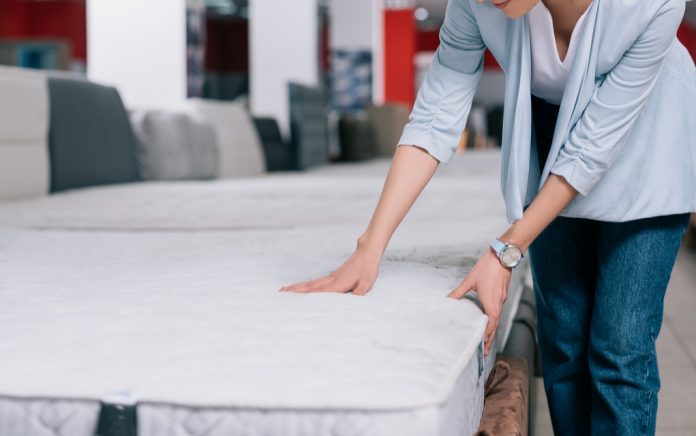
Did you know there is such a thing as an organic mattress? Do you want to know why you should consider getting one or more for you and your family? Then consider this: You spend about one-third of your life in bed, and that’s a lot of time to be exposed to toxins. Because if you aren’t already sleeping on an organic mattress, you are sleeping with the enemy: questionable chemical substances that can damage your health every time you close your eyes.
Organic mattress vs conventional mattress
Organic mattresses are free of synthetic materials, comply with organic standards (which you can check out below), and have not been treated with chemicals. Not all organic mattresses are the same; they can be composed of organic cotton, organic wool, or organic latex. They are durable, biodegradable, and hypoallergenic.
Read about mattresses: eco-friendly and conventional options
If you are wondering whether organic mattresses keep up with conventional ones when it comes to support, regulation of body temperature, and overall sleep quality, here’s the scoop. They reportedly are great at supporting your body, relieving pressure, and meeting our body temperature needs in the winter and summer.
A benefit you get from an organic mattress is that you are not contributing to more dangerous toxins in the air and thus helping to reduce your carbon footprint. Of course, the obvious advantage of going au natural with your mattress is that you are not exposing your body to dangerous substances every night while you sleep.
Are eco or green mattresses the same as organic ones?
When shopping for an organic mattress, don’t be fooled by words such as “green” or “natural” or “eco.” These are ambiguous terms and are not regulated. Mattresses advertised using these terms are not the same as organic products. Make sure you are getting an organic mattress by checking to see if the product meets the organic standards.
Read about why buy a natural mattress
Toxic substances in conventional mattresses
Conventional mattresses typically contain one or more of the following substances.
Foam: This is made from petroleum, and as you sleep on the mattress, volatile organic compounds (VOCs) are released from the foam and you may experience irritation of your eyes, nose, and throat, as well as headaches, nausea, and loss of coordination. In addition, propylene oxide and TDI (used to make polyurethane foam) can cause mammary tumors, while toluene is a neurotoxin. Another danger from foam is that is it highly flammable, yet it continues to be used because it is cheap to produce. Foam mattresses are typically heavily treated with chemical flame retardants, which are explained below.
Flame retardants: The most commonly used flame retardants are antimony (a toxic heavy metal that can cause heart, lung, and eye problems), boric acid (causes eye and lung irritation), and halogenated flame retardants. The latter ones can cause neurobehavioral changes, disrupt thyroid hormones, delay puberty and reproductive development, and damage nerve and brain function.
Chemical flame retardants are popular with mattress companies because they are much less expensive than, say, wool, which is a natural flame retardant but more expensive. Because mattress makers aren’t required to let consumers know what flame retardants they use, you need to be very cautious when making your purchase.
Latex: Synthetic latex is made from styrene and butadiene, both of which are VOCs and petroleum based. Manufacturers also may use additional toxins during processing. Exposure to styrene is associated with hearing loss, headache, depression, fatigue, weakness, and an increased risk of developing lymphoma and leukemia. Butadiene can damage the nervous system, irritate the skin and eyes, and may cause cancer.
Natural latex is made from the rubber tree and is expensive as well as time-consuming to produce. Some mattress makers will include a small amount of natural latex to their product and market them as natural latex, even though the majority of the latex is synthetic.
Vinyl: The production of vinyl involves toxic chemicals, including phthalates, dioxins, and heavy metals, which can cause various health problems ranging from triggering allergies and asthma to causing genital defects, cancer, damage to the developing brain, and behavioral problems in children.
Because vinyl is often used to make mattresses waterproof, they are commonly used in baby mattresses. This means infants are being exposed to toxins at a very early age. Manufacturers are not required to reveal that they use vinyl in their mattresses, so you must ask directly.
Comfort and Support
You can expect the same or superior comfort and support from organic mattresses when compared with conventional ones. As with any mattress, you need to try them out to see if they adhere to your needs for comfort and support. Therefore, if at all possible, visit a showroom and actually lie on the mattresses you are considering.
Mattress certifications
Organic mattresses are certified to one of several standards. The mattress you choose should meet these certifications. Here are a few of them.
- Global Organic Textile Standard is the main processing standard for organic fibers and textiles. It ensures the organic status of the textiles used in the produce, from harvesting of raw materials up through labelling of the final product.
- Global Organic Latex Standard is a standard that guarantees the presence of organic latex and finished latex foam mattresses. It specifies that at least 95 percent of the latex used is organic.
- OCS100 Organic Content Standard ensures the tracking of organic materials from their source to the finished product.
- Greenguard requires products meet the standards for more than 360 chemicals. A Greenguard certification guarantees that a mattress is low in phthalates, formaldehyde, VOCs, and other harmful toxins. Note that it is not a certification for organic materials.
Bottom line
Sleeping on an organic mattress is a healthy choice for you and your family. You have many fine brands from which to choose, and here at Natural Savvy we recommend Naturepedic because it meets all the high standards of an organic mattress.
Read this next: Bed Bugs: Do I Have Them and How Can I Get Rid of Them?
DISCLAIMER: This article contains affiliate links, which means that if you click on one of the product links, Naturally Savvy will receive a small commission so we can keep pumping out amazing articles like this one. Thank you so much for your support!
Sources
Aging for Toxic Substances & Disease Registry. Toxicological profile for toluene.
Agency for Toxic Substances and Disease Registry. Toxicological profile for toluene.
Centers for Disease Control and Prevention. Carcinogenic effects of exposure to propylene oxide. 1989 July
Global Organic Latex Standard
Global Organic Textile Standard
Kim BN et al. Phthalates exposure and attention-deficit/hyperactivity disorder in school-age children. Biological Psychiatry 2009 Nov 15; 66(10): 958-63
Jaakkola JJ, Knight TL. The role of exposure to phthalates from polyvinyl chloride products in the development of asthma and allergies: a systematic review and meta-analysis. Environmental Health Perspectives 2008 Jul; 116(7): 845-53
Phthalates and cumulative risk assessment: the tasks ahead. National Research Council (US) Committee on the Health Risks of Phthalates. Washington DC: National Academies Press, 2008.
United States Department of Labor. 1,3-butadiene.
US Department of Health and Human Services. Toxicological profile for polybrominated biphenyls. 2004 Sept.
Zhou T et al. Developmental exposure to brominated diphenyl ethers results in thyroid hormone disruption. Toxicological Science 2002 Mar; 66(1): 105-16










